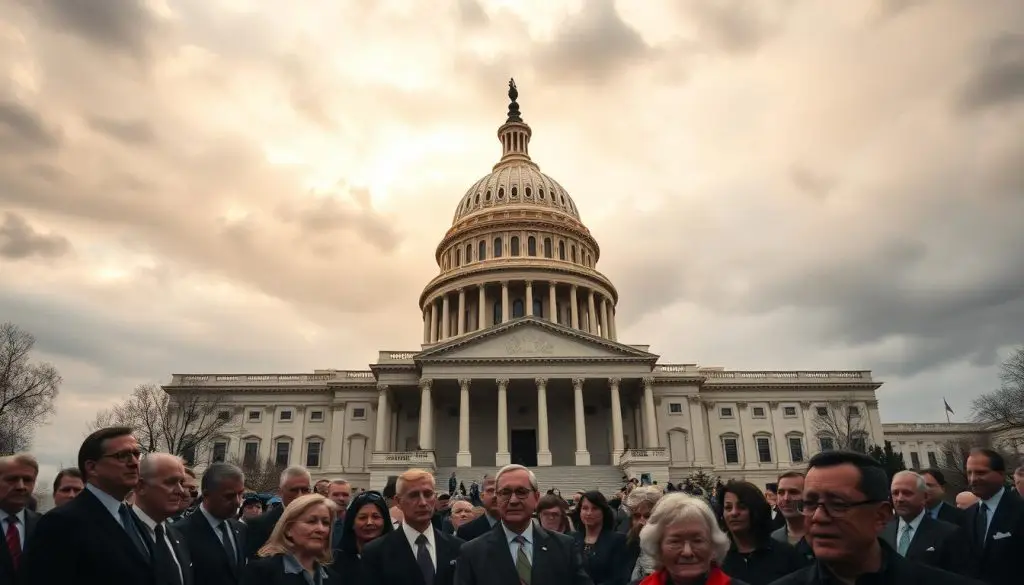Senate Confirms Deal to Reopen Federal Government
Breaking news: Senate confirms a bipartisan agreement to effectively end the shutdown and restore operations across federal agencies.

Senate Confirms Deal to Reopen Federal Government
I felt a collective exhale when the Senate confirms the framework of a deal for reopening the federal government. It’s not final, but momentum is real. Leaders are preparing a confirmation vote as soon as an evening session takes place.
In a moment that feels both fragile and firm, I can almost hear the hum of offices coming back to life.
Aides say the plan ties three full-year appropriations bills to a stopgap through January 30. Two texts surfaced Sunday, with Sen. Patty Murray signaling early support. That nod felt like a lighthouse in fog—steady enough to steer by. More political news at this link
The White House backs the direction as well, and that gives Senate approval a path. The politics are thorny. Republicans would make separate healthcare commitments, with a possible December vote on extending Affordable Care Act tax credits.
There is talk of reversing President Donald Trump’s firings of federal workers during the 40-day shutdown. Yet the contours shift. House leaders resist a health care vote, and Rep. Ritchie Torres says the plan does not go far enough.
This is breaking news, but it is also lived news—paychecks, clinics, and quiet kitchen tables.
I keep thinking about gates and keys. A confirmation vote is one gate. Party meetings are another. Government nominations and political appointments move in the background like gears.
But today’s gear is simpler: get the lights back on. For context on Sunday’s rare session and prior failed votes, see this Senate weekend coverage.
Key Takeaways
- The Senate confirms a framework to advance the reopening of the federal government, with a possible evening confirmation vote.
- The deal links three full-year appropriations to a stopgap that runs through January 30, backed by Sen. Patty Murray and the White House.
- Separate healthcare commitments include a possible December vote on Affordable Care Act tax credits, although details remain fluid.
- Lawmakers are weighing how to address firings of federal workers during the 40-day shutdown.
- Senate approval is not yet final, despite breaking news signaling growing bipartisan momentum.
- Government nominations and political appointments continue in the background as leaders focus on reopening.
Latest Developments and What’s in the Emerging Agreement
I often wonder what mercy looks like in policy. After 40 days of shutdown, we’re seeing a glimmer of hope. The Senate is moving forward, and hope is in the air.
I want clarity more than spin. Leaders say they’re working on a plan. They aim for a vote tonight. This could mean the Senate approves the deal, paving the way for a return to normalcy.
Three full-year appropriations bills and a stopgap through Jan. 30
The deal is simple and strong. It includes three full-year appropriations bills and a stopgap until January 30. Sen. Patty Murray’s support is a big sign of progress.
I looked at the deal’s details and felt a mix of relief and caution. It’s not perfect, but it’s a start.
Health care commitments: a December vote on ACA tax credits
On health care, there’s a promise of a December vote on ACA tax credits. This is a big deal for families with high premiums. A vote could ease the financial burden next year.
If the vote happens, it could be a game-changer. But if it doesn’t, families will face tough times again.
Reversing federal worker firings during the 40-day shutdown
Another essential part of the deal is fixing worker firings from the shutdown. These workers went unpaid and lost their jobs. Restoring their positions is a moral and policy necessity.
Can the Senate also show mercy? Restoring dignity is as important as a paycheck. It’s what brings people back.
White House position and early text releases backed by Sen. Patty Murray
The White House supports the deal, adding stability. Early drafts and Murray’s support show a united front. This is key when every vote matters.
I imagine the Senate floor: quiet, tense, but hopeful. Each step brings us closer to a solution. Will this partial fix be enough for tonight? We wait for the Senate’s decision.
Trump’s decision to start Nuclear Bomb testing again is opening some eyes on the political landscape of the dynamics between the US and Russia.
Senate confirms dynamics: confirmation vote math, Senate approval hurdles, and legislative process.
I watch the numbers like the weather. A single swing can change the day. The legislative process is not poetry, yet it moves me—step by step, vote by vote—until the Senate confirms or stalls. The math is tight, but it breathes.
We have seen this dance before. A decisive confirmation vote can signal momentum across political appointments and even echo into judicial appointments. But momentum only matters if it clears the next procedural hill.
Breaking the 60-vote threshold and the role of bipartisan meetings
To end the debate, 60 is the gatekeeper. Eight or more crossovers often decide whether the Senate confirms the next step. So, the meetings matter—quiet rooms, short lists, and a clock that doesn’t blink!
I keep asking: who will move first? Bipartisan talks shape the path more than speeches on the floor. In practice, the legislative process rewards patience as much as persuasion.
Approval proceedings: holds, unanimous consent, and the power of a single objection
Approval proceedings are fragile. One hold can stretch hours into days. Unanimous consent sounds gentle, yet a single objection is a hammer.
That is why timing rules the day. Leaders weigh whether to file cloture or seek a narrow lane through consent. Every senator knows the leverage and uses it.
Divisions among Democrats over health care scope and costs
Inside the caucus, health care stirs the most profound questions. How much cost relief is enough? Is it a modest change in progress, or a pause?
The debate is not abstract. It shapes whether a confirmation vote becomes a vehicle or a wall. When political appointments change, policy debates often follow suit, and tensions come to the forefront.
Key voices: Mike Rounds, Markwayne Mullin, Lisa Murkowski on path forward
Sen. Mike Rounds signals only a few issues remain—close, but not done. Sen. Markwayne Mullin points to the simple step: get on the bill, then argue the details. It’s a practical creed.
Sen. Lisa Murkowski hears a shift in tone on health care and calls it progress. In this moment, the approval proceedings, the legislative process, and the final floor test braid together—where judicial appointments and political appointments have taught the same lesson: count the votes, honor the rules, and move.
Senate confirms Deal Conclusion
As the Senate confirms a way to end the shutdown, I see the gears of government moving. The process is clear: cloture math, holds, text drops, and long meetings. But it’s not just about numbers; it’s about people’s lives.
Workers hope for their jobs back, travelers wait for flights, and families worry about health care costs. Senate approval is more than a headline; it’s a breath of life.
The White House supports the plan, giving it strength. Sen. Patty Murray backs three full-year bills, guiding the way. Sen. Mike Rounds is optimistic, and Sen. Markwayne Mullin outlines the steps that need to be taken. Sen. Lisa Murkowski sees progress.
Power should be used to reopen parks, restart research, and paychecks. A quick confirmation vote could help restore normalcy.
But there are challenges. The 60-vote threshold is a hurdle. One objection can delay things. Democrats disagree on the scope and cost, and the House may not agree on healthcare.
Yet, the path seems possible, thanks to new Senate rules on bundles. Political appointments are real people needed for safety nets, airports, labs, and schools.
If this deal works, it won’t be perfect. But sometimes, enough is enough. Senate approval can turn into action when it meets public needs.
Then, the confirmation vote is more than a formality. It’s a promise kept in our daily lives, where duty and country come together.
Senate confirms Deal FAQ
What does “Senate confirms” mean in this context?
It means the Senate has shown support for moving forward with a deal. This is through a vote to proceed. It’s a big step, but not the final approval.
What’s actually inside the emerging agreement to reopen the government?
The deal includes three full-year appropriations bills. It also has a continuing resolution to keep funding at current levels until January 30. Sen. Patty Murray supports all three bills.
How do the three full-year appropriations bills work alongside the stopgap through January 30?
The full-year bills fund specific departments for a year. The stopgap maintains current funding levels until January 30. This prevents a shutdown while details are worked out.
Are there healthcare pieces, such as Affordable Care Act tax credits, in the deal?
Republicans might agree to extend ACA tax credits in December. But the House hasn’t decided yet. This makes the deal uncertain.
Will the agreement reverse President Donald Trump’s firings of federal workers during the 40-day shutdown?
Lawmakers are talking about reversing the firings. It’s a top priority for Democrats. But no decision has been made yet.
Where does the White House stand, and why does Sen. Patty Murray’s backing matter?
The White House supports the deal, according to Punchbowl News. Sen. Patty Murray’s support shows Senate appropriators are serious about moving forward.
What Senate confirmation vote math is needed to move the deal forward?
Leaders need 60 votes to end the debate. Democrats and Republicans are working together. A vote to proceed might happen soon.
How can one senator slow down Senate approval?
One senator can block fast-tracking with an objection. This forces long debates and cloture votes, slowing down the approval process.
Why are some Democrats divided over the health care scope and costs?
Some Democrats want more on affordability. Rep. Ritchie Torres says the plan isn’t enough. House Republicans are unlikely to vote on health care, making the situation more challenging.
What are key senators saying about the path ahead?
Sen. Mike Rounds thinks only a few things are left. Sen. Markwayne Mullin says the Senate can vote to move forward. Sen. Lisa Murkowski sees progress, showing hope.
What happens next in the legislative process?
Expect meetings, more bill text, and a procedural vote. If 60 votes are reached, senators will debate and vote. Then, the House will act. If both pass, the President signs it.
How soon could federal services resume if the deal advances?
If the Senate and House pass the deal, services can start again. Agencies can begin under the continuing resolution. Full-year bills take effect where they apply.








